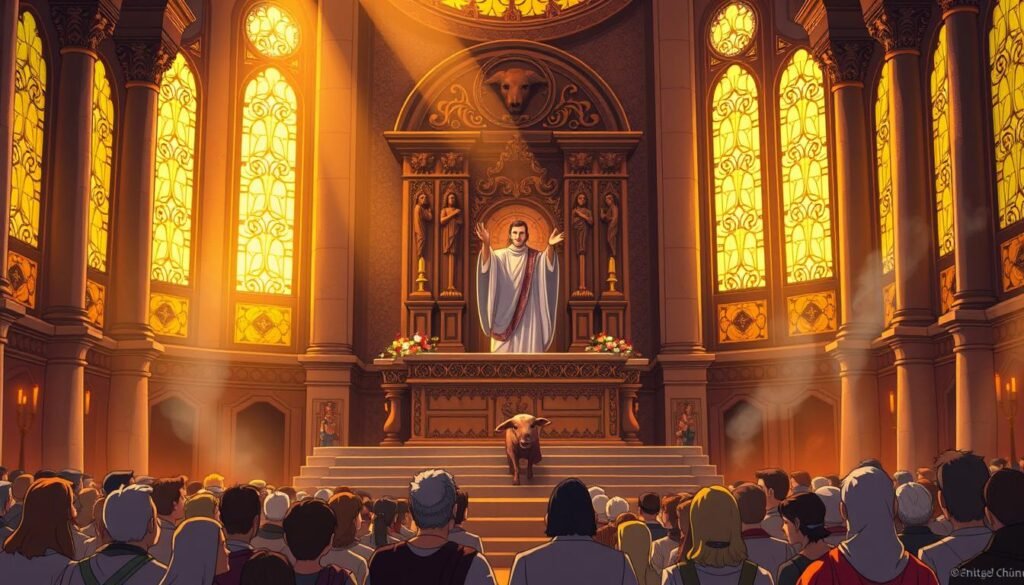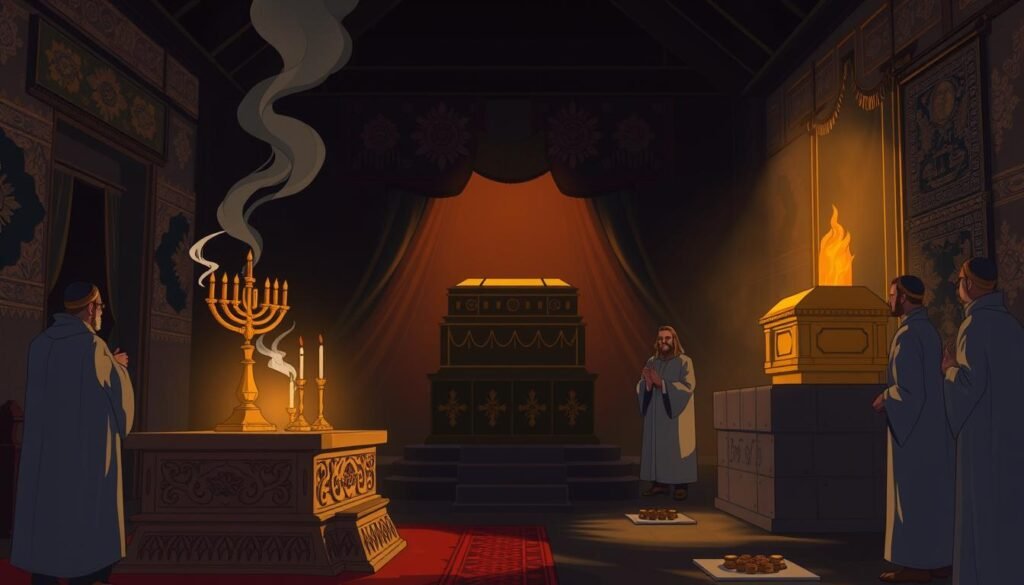Ever felt guilty or failed and thought you weren’t worthy of God’s love? The biblical meaning of sacrifice is here to help. From the first animal skins in Genesis to Jesus’ sacrifice on the cross, the Bible shows God’s plan to make things right with us. Each sacrifice in the Old Testament pointed to Jesus, the perfect Lamb who could pay for our sins.
What does sacrifice in scripture really say? These rituals were not just empty acts. They showed that sin needed a substitute. The story of Abel and Cain (Genesis 4:2-5) teaches us that only God’s chosen sacrifices could make things right. This idea reached its peak with Jesus’ sacrifice (Hebrews 10:12).
Every grain of incense and lamb was a promise of something greater. The biblical sacrifice meaning goes beyond old rituals. It shows us God’s justice and mercy. Just like Job’s sacrifices for his kids (Job 1:5) foreshadowed Jesus, the Passover lamb’s blood (Exodus 12) looked forward to the cross. This article dives into how these sacrifices, from Genesis to Revelation, all point to Jesus as the true atonement for our sins.
Understanding the Biblical Concept of Sacrifice
The biblical sacrifice definition comes from old words. In Hebrew, qorbān (קרבן) means “approach” or “gift.” It shows how we move towards God. Greek texts use thysia, which means “to consecrate.”
These words show sacrifice is for worship and making things right, not just a ritual.
Etymology and Original Meaning in Hebrew and Greek
In Hebrew, qorbān is used over 300 times. It talks about giving animals, grain, and even prayers (like in Psalm 116:17).). The Greek word proskynesis in Matthew 2:11 adds a layer of worship. It shows sacrifice is about connection.
Experts say olah (burnt offerings) meant giving everything, showing total surrender.
The Evolution of Sacrifice Throughout Scripture
The idea of sacrifice changed from Cain’s bad choice to the detailed Levitical rules. Early leaders built altars to mark covenants (Genesis 12:7-8). Moses then set out clear rules in Exodus-Leviticus.
By the New Testament, Jesus changed the idea of sacrifice. He said, “Greater love has no one than this, that someone lay down his life for his friends” (John 15:13 ESV). This shows sacrifice now means giving up for others, not just animals.
God’s Purpose Behind Sacrificial Systems
God’s reason for sacrifices was more than just following rules. Hebrews 10:1 says sacrifices were “a shadow of the good things to come,” pointing to Jesus’ sacrifice. Proverbs 21:3 says doing justice and judgment is more pleasing to God than sacrifice.
The main goal was to teach us to rely on grace. This is through the idea of substitutionary atonement.
Old Testament Foundations: The First Sacrifices
Genesis 3:21 shows God’s first sacrifice in the Bible. After Adam and Eve sinned, God used blood to cover them. This act showed how an innocent life could cover human mistakes.
“The Lord God made garments of skin…”
The story of Cain and Abel in Genesis 4:3-5 teaches us more. Abel’s animal sacrifice pleased God, but Cain’s plant gift did not. Hebrews 11:4 says Abel’s faith was shown through his sacrifice. Cain’s lack of faith led to his sacrifice being rejected.
Noah’s sacrifice after the flood is also important. In Genesis 8:20, Noah offered a burnt sacrifice. God then promised not to curse the earth again because of humans. This sacrifice started a new promise between God and humans.
These early sacrifices laid the groundwork for Israel’s later rituals. They show that true worship means admitting our mistakes and trusting God’s grace. By studying these stories, we see how God’s plan for saving us began with these sacrifices, leading to Jesus’ ultimate sacrifice (Colossians 1:20).
Key Bible Verses About Sacrifice and Their Context
Understanding bible verses on sacrifice means looking at their history and meaning. Levitical sacrifices were part of ancient worship. Prophetic teachings changed their purpose. These texts show how sacrifice changed from just rituals to being about relationships.
Leviticus: Framework for Divine Communion

The first five chapters of Leviticus explain levitical sacrifices. There are burnt, grain, and peace offerings, each with its own rules. Leviticus 17:11 says, “the life of the flesh is in the blood, which makes atonement.” These rituals were a way to connect with a holy God.
Prophetic Teachings on Sacrifice
Prophets like Hosea 6:6 and Isaiah 1:11-16 spoke out against empty rituals.
Scripture says mercy is more important than sacrifice
—a message that also warns against treating others badly. Psalm 51:16-17 talks about a broken spirit being more important than sacrifices. This matches the prophets’ call for justice over just doing things right.
New Testament Transformations
Hebrews 10:1-18 talks about Christ’s “single sacrifice” compared to the endless offerings of the Old Testament. Romans 12:1 says sacrifice is about living for God, not just animal blood. These texts show how sacrifice changed from following rules to being about real devotion.
These verses together show how sacrifice changed from Levitical rules to Christ’s eternal work. They teach us about God’s ongoing call for true devotion.
The Five Major Types of Offerings in Levitical Law
Leviticus carefully lists the types of offerings in Leviticus. These rituals were key to the biblical sacrificial system. They showed the Levitical sacrifice meanings as ways to make amends, worship, and connect with God.
Inherent in sacrifice is the social concept of reciprocity: a human being offers (or vows to offer) something to a deity in hope of receiving some kind of relational or material benefit…
Burnt Offerings (Olah): Complete Dedication)
The burnt offerings (olah) needed the whole animal—bull, sheep, or dove—to be burned. This showed total giving, with nothing kept by the person. The smoke went up, showing complete devotion (Leviticus 1:3-17).
Grain Offerings (Minchah: Thanksgiving and Devotion)
Grain offerings (minchah) were made with flour, oil, or baked goods. A part was burned, showing thanks for God’s gifts. It was a way to thank God for His care (Leviticus 2:1-16).
Peace Offerings (Shelamim: Communion and Fellowship)
Peace offerings (shelamim) led to meals shared by all. This showed unity in the covenant. Meat was shared between the altar and those celebrating (Leviticus 3:1-17).
Sin Offerings (Chattat: Atonement and Forgiveness)
Sin offerings (chattat) were for mistakes. Animals like goats or bulls were used. Blood was sprinkled to clean the altar and the person (Leviticus 4:1-21).
Guilt Offerings (Asham: Restitution and Cleansing)
Guilt offerings (asham) included money and 20% extra for mistakes. This was to make things right and clean spiritually (Leviticus 5:14-16).
These rituals point to Jesus’ sacrifice. His body and blood met all the Levitical needs (Hebrews 10:1-18). The types of offerings in Leviticus show God’s plan for our redemption through Christ.
Abraham and Isaac: The Ultimate Test of Faith
Genesis 22 tells us about Abraham’s big test of faith. He was asked to Abraham sacrifice Isaac, his only son. This was a huge test of Abraham’s trust in God’s promises.
God asked Abraham to give up Isaac, who was very special to him. Abraham knew this was a big deal. He packed up and went on a three-day journey with two servants.
The Bible says Isaac was Abraham’s only son twice. This shows how hard it was for Abraham. This Moriah sacrifice was a big deal.
“God himself will provide the lamb for a burnt sacrifice, my son,” Abraham said (Genesis 22:8). He knew God would find a way. The ram with thorns was a sign of God’s plan. The angel stopped Abraham, showing God was pleased with his faith (Genesis 22:12).
Abraham showed us that faith and sacrifice go together. He was ready to give up Isaac, who was very important. Hebrews 11:19 says Abraham believed God could bring Isaac back to life.
This story shows us that God’s plan is always bigger than ours. Abraham’s story teaches us to trust God, even when it’s hard.
Abraham’s story teaches us a lot about faith. He was willing to give up everything, trusting God would take care of him.
The Sacrificial System of the Tabernacle and Temple
The sacrificial system was key for Israel’s worship. It started with the tabernacle and later the temple. This system helped keep the covenant with God alive. It showed how Christ’s sacrifice would later fulfill these rituals.

The Role of Priests in Sacrificial Worship
Aaronic priests were God’s helpers. They wore linen to show they were pure. They used incense and blood to clean the temple.
Only the high priest could go into the Holy of Holies. This was on Yom Kippur. He showed the nation’s need for forgiveness.
The Day of Atonement: Yom Kippur
“The goat shall bear on itself all their iniquities to a solitary land” (Leviticus 16:22).
Yom Kippur was an important day. It had two goats: one was sacrificed, the other was sent away. The high priest first offered a bull for his sins.
Then, he sprinkled blood seven times on the mercy seat. This Day of Atonement sacrifices showed Israel’s need for God’s grace. It was a shadow of Christ’s perfect sacrifice.
The Symbolic Meaning of Blood in Hebrew Sacrifice
Leviticus 17:11 said blood was for atonement. It was applied to altars and the sanctuary. This showed life was transferred from the animal to the person.
This idea was at the heart of the temple’s sacrifices. It showed how serious sin was. And how God needed a way to forgive humans.
Jesus Christ: The Perfect and Final Sacrifice
At the heart of biblical teachings, Christ as sacrifice completes the old stories of sacrifice. Unlike animal sacrifices that needed to be done over and over, Jesus’ death was a Jesus perfect sacrifice. It was a single, forever act. John 1:29 says, “Behold the Lamb of God who takes away the sin of the world,” showing Jesus as the final sacrifice.
“How much more will the blood of Christ, who through the eternal Spirit offered himself without blemish to God, purify our conscience from dead works to serve the living God.”
Hebrews 10:10 says Christ’s sacrifice made us forever clean. His death on the cross gave us atonement of Christ for all sins. It met the old rules for a perfect sacrifice. Unlike the yearly Day of Atonement, Hebrews 9:24 says Christ went straight to heaven, opening the door for all to meet God.
The torn temple veil (Matthew 27:51) shows this open door. It means everyone can now reach God.
Romans 3:25 talks about Christ as the one who made things right with God. His sacrifice was not just for a moment. It gave us eternal forgiveness (Hebrews 9:12). The cross worked because of His perfect life and death, showing both justice and love. This truth tells us to rely on His work, not our own (Ephesians 2:8-9).
Living Sacrifices: New Testament Teachings on Devotion
Scripture changes how we see sacrifice. It’s not just about rituals anymore. Paul says in Romans 12:1 to give your whole self to God. This living sacrifice meaning is about being devoted every day, thanks to Christ’s sacrifice.
Romans 12:1-2: Presenting Your Bodies as Living Sacrifices
Romans 12:1-2 talks about Romans 12 sacrifice. It’s about giving up to God’s plan every day. It’s about choosing God’s will over what we want. This comes from reading and understanding God’s Word.
Sacrificial Living in the Epistles
Christian living is more than just Romans. In Philippians 2:17, Paul says he’s giving himself like a drink. Hebrews 13:15 says we should praise God as a sacrifice. And 1 Peter 2:5 says we’re all priests, making spiritual sacrifices.
The Priesthood of All Believers
Revelation 1:6 and 1 Peter 2:9 say we’re all royal priests. This Christian sacrificial living means everyone in the church has a role. We honor each other and do good works. This shows the power of the gospel to change us.
Sacrifice as Worship: Beyond Ritual to Relationship
The spiritual sacrifice meaning in Scripture changes from physical offerings to deep devotion. Worship as sacrifice goes beyond animal sacrifices or temple rituals. It’s about living a life that follows God’s commands, not just doing ceremonies.
David’s Understanding: A Broken and Contrite Heart
David says in Psalm 51:17 that God hates empty rituals. He writes, “A broken and contrite heart you, God, will not despise.” This shows true worship needs humility, not just doing things outwardly. It’s about being sincere and repentant, not just making sacrifices (Psalm 51:16).
Micah’s Declaration: What Does the Lord Require?
Micah 6:8 says true worship is about justice, mercy, and humility. The prophet says to “do justice, love kindness, and walk humbly with your God.” This is like Jesus’ message in Matthew 23, where being faithful inside is more important than just doing things outwardly.
Hosea’s Insight: Mercy Over Sacrifice
Hosea 6:6 says God wants mercy, not sacrifice. God values being in a real relationship with us more than following rules. This is like what Jesus said in Matthew 9:13, calling people to change their ways, not just make offerings. Spiritual sacrifice now means loving others as Christ loved us (John 13:34).
Learn more about these ideas with Bible verses for life situations. The New Testament shows sacrifice is living a life of service. Believers are called to be “living sacrifices” (Romans 12:1), showing Christ’s love in our daily choices.
FAQ
What is the theological foundation of sacrifice in the Bible?
Sacrifice in the Bible is about how we can get close to God. It solves the problem of sin and our distance from God. It shows how we can be made right with God from the start to the end of the Bible.
How does the concept of sacrifice evolve in Scripture?
Sacrifice starts with simple altars and grows to the detailed Levitical system. It ends with Jesus’ sacrifice. This shows a deeper spiritual journey of love, forgiveness, and worship.
What are the key aspects of Old Testament sacrifices?
Old Testament sacrifices include early stories like God’s gift of animal skins to Adam and Eve. They also show the difference between Cain and Abel’s offerings. These stories teach us how to approach God, admit our sins, and find forgiveness.
What is the significance of the Levitical sacrificial laws?
Levitical laws, in Leviticus 1-7, explain different sacrifices and how blood cleanses us. Psalms and prophets then talk about the heart’s sacrifice, not just following rules.
Can you explain the five major types of offerings?
There are five main types of offerings:
– Burnt Offerings (Olah) show complete dedication,
– Grain Offerings (Minchah) are for thanksgiving,
– Peace Offerings (Shelamim) are about sharing,
– Sin Offerings (Chattat) are for forgiveness, and
– Guilt Offerings (Asham) are for making things right.
What is the significance of Abraham’s willingness to sacrifice Isaac?
Abraham’s willingness to sacrifice Isaac tests his faith and shows God’s plan. It raises questions but shows God’s love and plan for us.
How did the Tabernacle and Temple influence the sacrificial system?
The Tabernacle and Temple set up the place and rules for sacrifices. Priests and rituals like the Day of Atonement show sacrifices as a bridge between God and people.
In what way does Christ fulfill the sacrificial system?
Christ’s sacrifice is the final one, better than all others. It brings complete forgiveness and opens heaven’s door for all believers.
What does living as a ‘living sacrifice’ mean in the New Testament?
Living as a ‘living sacrifice’ means giving your life to God. It’s about devotion, worship, and living a life of sacrifice, gratitude, and doing what’s right.
How is the New Testament’s view of sacrifice different from the Old Testament?
The New Testament changes sacrifice from just rituals to a way of life. It focuses on being a servant, worshiping with your heart, and living for God, not just following rules.

Rockin’ the faith, one verse at a time!
Growing up, the Bible’s stories deeply impacted me. Now, with over 15 years of preaching experience, I blend timeless teachings with modern technology, making them relevant for today’s world.
Bible Hub Verse is my platform to share historical insights and thought-provoking articles, exploring both familiar and uncommon Christian topics. My passion is building a welcoming online space for everyone to learn, grow in their faith, and discover the Bible’s enduring message.
Join the journey!
God bless you.





